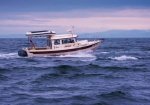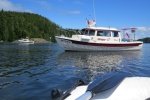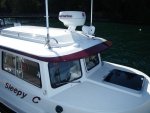Dennis, Welcome here. Glad you asked.
There are a few of us who do boat alone. Maybe not always but mostly. Some of us like that, some don’t, and for me personally, I do and don’t it depends on where I am, for how long and who might be with me. I single-hand about 98% of my boating time. (Longest trip, 100 days solo). Sometimes I like that and as I said sometimes not because there are things out there that are just too beautiful not to share. I rarely launch for a day trip. Generally it is for 3-4 days or weeks at a time.
There are several considerations, and Roger just mentioned some. I will repeat some to emphasize the importance.
SAFETY HAS TO COME FIRST. So, you do things that keep you safe, and make your trip safer. You do spend some extra $$$ to ensure that safety.
From Roger{bum’s} post,
“There are a lot of things you can do to increase safety - kill switches on your person, a small handheld radio and PLB on the life vest + a float plan filed with someone all help to increase safety.”
First in the most important list for me is the kill switch. Mine is the MOB+ by Fell Marine. It kills the engines if I go overboard, or alarms if my passenger goes overboard. The engines stop in about 3 seconds. Even if a walk away from the boat on the dock.
Second, A PLB or Personal Locator Beacon, (mine is ACR brand), sends a message via satellite to the most local Search and Rescue service, either on land or sea. It is Always on my PFD, which is ALWAYS on when I am on the boat. NO EXCEPTIONS.
Third, an auto inflating, off shore PFD with a sling. (As mentioned above.)
Fourth, a good, waterproof, hand held VHF, On my PFD, 90% of the time. If it is not on me, it is where I can grab it in 2 seconds.
Fifth, is some kind of a float plan. There has to be some sort of preset plan for contact, including a time and a contingency plan for if there is no call or contact. There are ways. Cell phone, Spot, Garmin InReach, Sat Phone, Ham radio or whatever you can devise that is reliable.
Sixth. Make your boat easy to handle by yourself. Have fenders and lines arranged for easy access and deployment. Avoid having to wander around on the gunnels tying fenders, or being up on the bow “messing” with the anchor. ALWAYS DO EVERYTHING THE SAME WAY, so that it is always in the same place, and always ready. That way you never have to search for anything.
Seventh. Often, buddy boating, (especially at first), is a great way to go. You have your boat, your space, and your ways, but have someone within reach and accessible via VHF if you get into trouble.
Eighth. IF you anchor, DO NOT leave your boat until you are sure you have a good hook up. Back down on your anchor, until the bow tugs down, then relax and wait. Give it plenty of time, (half an hour at least) before leaving the vessel. Take that time to note where you are, and how your boat reacts to the anchor.
Ninth. Always know where you are. In the event something bad happens, you do not have time to stop and figure out where you are. Know how to use your DSC button on your radio for emergency notification. That will work IF you have set up your VHF with an assigned MMSI number. Do That.
Ten. Go out and enjoy. If it takes making out a check list to go over to be sure everything is done, in the right order, and all is functioning Do That. BUT, do go out and enjoy your boat. You can do it; many have and Yes, it does work and Yes it does get easy. And yes, sometimes you won’t like it, but most of the time you will.
Harvey
SleepyC :moon




